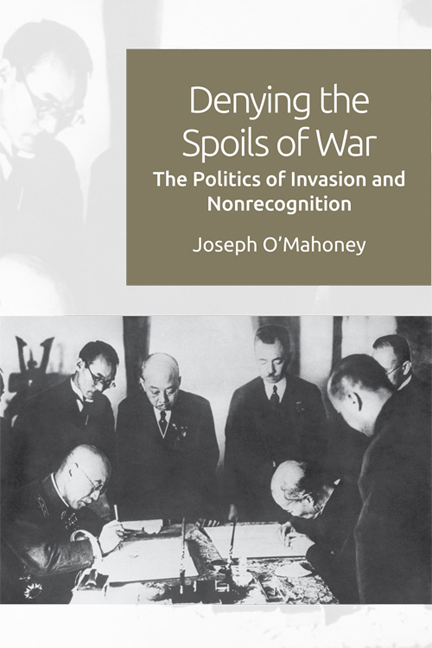Book contents
- Frontmatter
- Contents
- List of Figures and Tables
- Acknowledgements
- List of Acronyms and Abbreviations
- Introduction
- 1 Rule Maintenance: the Logic of Symbolic Sanctions
- 2 The Manchurian Crisis
- 3 The Abyssinian Crisis
- 4 Turkey, Cyprus and the Turkish Republic of Northern Cyprus
- 5 The Independence of Bangladesh
- 6 The Uncertain Fruits of Victory: Variation in Nonrecognition
- Conclusion
- Bibliography
- Index
3 - The Abyssinian Crisis
- Frontmatter
- Contents
- List of Figures and Tables
- Acknowledgements
- List of Acronyms and Abbreviations
- Introduction
- 1 Rule Maintenance: the Logic of Symbolic Sanctions
- 2 The Manchurian Crisis
- 3 The Abyssinian Crisis
- 4 Turkey, Cyprus and the Turkish Republic of Northern Cyprus
- 5 The Independence of Bangladesh
- 6 The Uncertain Fruits of Victory: Variation in Nonrecognition
- Conclusion
- Bibliography
- Index
Summary
INTRODUTION
In this chapter, I analyse the crisis surrounding Italy's 1935 invasion and subsequent annexation of Ethiopia, or Abyssinia as it was sometimes referred to at the time. As in the other cases in this book, one state used premeditated military force against the army of another state. The victorious invader then occupied a portion of the territory of the other state and supported a change in the government authority over that territory. Whereas in the other cases the outcome was a new state, like Manchukuo, Bangladesh or the TRNC, in the Ethiopia case, the outcome was Italy's direct possession of Ethiopia. The King of Italy styled himself ‘Emperor of Ethiopia’. In the Manchurian case, there was widespread uncertainty or disagreement over whether Japan's actions were aggression. The Japanese military had had relatively limited aims, in that only a portion of Chinese territory was occupied and outright annexation was foregone in favour of establishing a new state, at least nominally under the control of ethnic Chinese. By contrast, the Italian conquest of Ethiopia was obviously premeditated and was aimed at the formal annexation of the entire country.
The Italo-Ethiopian crisis is thus especially interesting because the use of force was unambiguously treated as a norm violation and yet within the space of a few years a large proportion of the international community was treating the spoils of that use of force as legitimate. In addition, because the collective security system embodied in the League of Nations Covenant collapsed, this case also shows that the threat of dissolution is not a phantom fate for an institutional rule. It provides a powerful answer to the common question asked of nonrecognition, ‘Why not do it?’
The primary goal of the study of this case is thus to find out why nonrecognition did not happen. Why did states, such as the UK, that condemned Italian aggression and imposed economic sanctions on Italy, then turn around and recognise Italian sovereignty over Ethiopia? These findings help to build the model of rule maintenance. As the main purpose of this study is theory-building rather than theory-testing, the case comparisons are not used to falsify pre-formed hypotheses, but to aid in the construction of the model and suggest potential sources of variation.
- Type
- Chapter
- Information
- Denying the Spoils of WarThe Politics of Invasion and Nonrecognition, pp. 74 - 110Publisher: Edinburgh University PressPrint publication year: 2018



